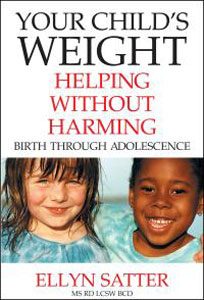

Family Meals Focus
The Ellyn Satter Institute Newsletter
School nutrition horror stories
by Ellyn Satter, Registered Dietitian and Family Therapist
In my view, we need to provide, not deprive at school and make wise use of “forbidden food,” not eliminate it altogether. That principle has been undermined by the 2010 Healthy Hunger-Free Kids act, which requires schools to offer lunches that limit calories, are low in fat, sugar, and sodium and are heavy on whole grains, fruits and vegetables. Based on those principles, school personnel use strong arm tactics to teach, shame, coerce, or downright force kids to eat “right.
School nutrition regulations put clean tools in dirty hands
Why would the “making school meals healthier” campaign be a problem? Because it appears to give license to strong-arming with self-styled nutrition principles. All public schools in the St. Paul, MN, district will be declared “sweet-free zones” and second helpings banned by the end of this school year. Reminders have been sent to teachers, students, and parents that “sweet, sticky, fat-laden, and salty treats” aren’t allowed during the school day.” In a Pioneer Dispatch OpEd piece, “Why I’m sour on St. Paul School’s ‘no-sweets’ policy” Katja Rowell, MD, observed that “when foods are overly controlled and restricted, the result is keen interest, desire and sneaking.”
School anti-obesity programs do harm
Put this card in your child’s lunch: “Please let my child eat his lunch in any order that he wishes. He may finish his food – or not. It is up to him. If you have a problem, please talk with us.”
James McGuire, MD, a New Hampshire pediatrician, says “I keep seeing anti-obesity programs that do harm, like a school cafeteria program in which the child has a debit card to buy lunch, and the parent enters online what the child can or can’t buy. So if he tries to buy a brownie, the cafeteria lady says ‘sorry!’ in front of everyone in line. One of my parents told me that in her son’s school a dietitian goes around at lunch-time and says things like ‘You shouldn’t eat that cookie before you eat the rest of your lunch,’ and ‘Don’t you think you should eat more from each food group?’ or ‘You probably shouldn’t eat that!’ Her child was so traumatized that he’s not eating any lunch at all. He tries to find reasons not to go to the cafeteria.”
Children are coerced to eat or drink
An RD who is concerned about her 5th grade daughter’s teacher’s nutrition program “for academic success” says she is remaining anonymous to protect her daughter from backlash. The teacher’s daily requirements are that children eat 3 snacks consisting of one protein and one fruit or vegetable, and drink 32 ounces of water. If they eat their snacks and drink all their water, they receive a homework pass.
Unqualified people teach “nutrition” lessons
LG, another RD who wants to remain anonymous for the same reason, says her principal paid a woman who is a self-taught health guru to present her “healthy eating program” emphasizing fruits and veggies. The guru restricts her own children’s sugar, fat, and wheat, and had a contest for which class could eat the most veggies in a week. “I feel that this health program has entitled the little girls to comment on everyone’s weight and what they are eating. My 10-year-old daughter is average size and not built like a ballerina or gymnast, as are a group of little girls in the class. She has legs of steel and is a mad woman on the soccer field. I let her take dessert (two small oatmeal cookies or mini candy bars or mini muffins) to school. She has been taunted about weighing over 80# and for eating dessert even though she is ‘big.’ I tried to explain to the principal that it is bad to judge children on what they eat; that opens the door to their judging each other.” This story has a happy ending: LG had another meeting with the principal and counselor. “Prior to the meeting I took them your books and I know the counselor read them and internalized them. They are backing off on their ‘healthy eating program.’”
Children are shamed
A mother of a 10-year old says the teacher took away her child’s Goldfish crackers and told the child (in front of the other kids) they were unhealthy and that she should be eating more fruits and vegetables. He then returned the crackers and made her put them in the trash. Says the mom, “Most days I send her with fruits, veggies, cheese, yogurt, a sandwich or soup, and sometimes crackers, and I let her choose what, how much, and if she wants to eat when she unpacks her lunch. Her body is a little larger than the other kids’, and the shaming will exacerbate her already unhealthy relationship with food. We turned to the division of responsibility in feeding because the restrictive diet I’d been told to follow only resulted in her gaining more weight and hoarding ‘bad’ food in her closet.”
Good nutrition education supports parents
Excellent nutrition education in the schools supports and works with parents. It does not circumvent, undermine, or criticize them, directly or indirectly through their children. Facebook readers were outraged at the shaming episode, and made the following recommendations:
-
Talk with the teacher to get his version of what happened. Since his behavior is in sync with today’s extremist attitudes on food selection, the child’s report is likely to be accurate.
-
Talk parent rights, not good-food, bad-food. Many schools have healthy snacks policies. The teacher has his own interpretation, and is applying muscle. Don’t argue. Instead, point out that foods your child brings to school represent your best judgment/capability and that you expect him to support, not undermine that.
-
Talk with the principal, not to tattle on the teacher, but to get a wider audience. Tell her about the division of responsibility in feeding. Tell her you do not want interference with your child’s eating: what, how much, in what order.
-
Work on making non-interference a school-wide program. This might involve the principal, school counselor, school nurse, lunchroom personnel, PTO. It is a lot of work, but it is that important.
Help your child defend himself against school eating interference
Teach your child to say, “my parents say I don’t have to eat all my food or eat it in any order. If I want to eat only dessert, it is okay.” Write it down on a card and put it in your child’s lunch: “I chose the food for my child’s lunch, and trust him to determine what and how much to eat of what I provide. Please let him eat in any order that he wishes. He may finish his lunch – or not. It is up to him. If you have a problem with this, please talk with us.”
Explore
Understand and Apply ecSatter
For help with raising your big child or your small child to feel good about himself and have the body that is right for him, read Ellyn Satter's Your Child’s Weight: Helping Without Harming
Satter’s Division of Responsibility in Feeding addresses child obesity
- To prevent child overweight and obesity from birth, support parents in following sDOR.
- To treat child overweight and obesity at any age, restore sDOR and trust the child’s own homeostasis to restore appropriate growth.
Provide, don't deprive, at school
- Appendix G, Your Child’s Weight, Feeding and parenting in the school setting.
- Appendix H, Secrets of Feeding a Healthy Family, Nutrition Education in the Schools.
- Children and their eating: Ellyn Satter’s guidelines on school nutrition
- Comfortable Cafeterias
- Healthy eating at school
- Nurturing children at school
- Nutriendo a los Niños en la Escuela
- Packing a good-tasting and filling school lunch
- Provide, don’t deprive, at school
- School nutrition horror stories
- Schools are not weight-loss camps

